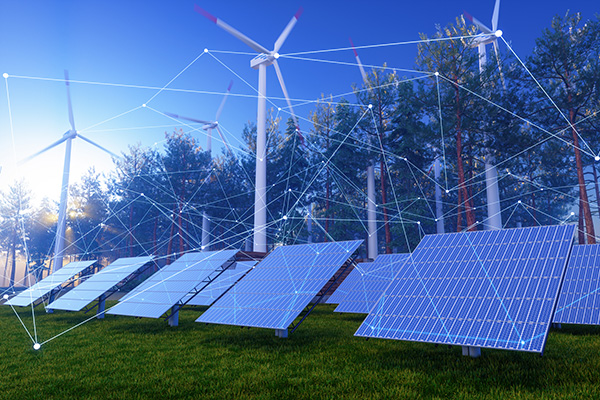Leveraging better utility data can reduce emissions by empowering intelligence at the edge.

by Luke Scheidler, Senior Product Manager of Itron
Decarbonization is a pressing global issue. The increasing frequency of environmental disruptions has underscored the urgent need to mitigate the impacts of global warming and climate change. Despite over 140 countries aiming for net-zero carbon emissions by 2050, United Nations data shows that current plans are off track to meet this goal. In light of this challenge, how can utilities help?
Integrating renewable energy has become a crucial factor for mitigating the effects of climate change and reducing carbon emissions. While this transition from fossil fuels to renewable energy sources is gaining momentum, the future of the modern grid is dependent on leveraging more intelligence at the edge. Through edge intelligence, utilities can access insights into customer energy usage, peak demand periods and load shifts throughout the day. This empowers utilities to make informed decisions that not only optimize energy use but also propel efforts for reduced emissions. However, the industry still faces some persistent hurdles for decarbonization efforts: outdated and difficult to access data.
In the context of today’s climate-conscious landscape, transparency surrounding energy use and carbon emissions is no longer optional, it is essential. The increasing number of companies setting ambitious net-zero goals and the emergence of stricter regulations requiring comprehensive emissions reporting are two key factors demonstrating this demand.
For any decarbonization strategy to be successful, it needs a solid foundation of granular data that provides deeper insights into energy consumption and emissions. While some utilities make consumption data readily available, it remains difficult for large corporates and third parties providing decarbonization services to access data across many different utility services territories. Utility companies and standardized data access solutions, like those using the Green Button Standard, play a crucial role in enabling better access to the data corporations need to track and make progress towards decarbonization goals.
Real-time emissions data and 24/7 clean energy accounting are becoming more popular and signal a need for not only better access to utility consumption data generally, but more access to real-time, high-resolution consumption and distributed energy resource (DER) data. A large variety of parties can use those data for both operational and reporting use cases. Demand response programs, for example, have long operated based on how constrained the grid is and how expensive capacity is. Now, especially with battery storage and increased renewables, it is important that our DER management programs also shift load in a way that optimizes for emissions reductions as batteries can increase carbon if not operated properly.
Through increased control and visibility at the edge of the electric distribution network, utilities can access a stream of granular data on energy consumption. This data goes beyond simple meter readings; it offers insights into real-time appliance and behind-the-meter DER patterns, peak demand fluctuations and even potential grid issues.
By leveraging grid edge intelligence, utilities can not only identify areas with high energy consumption and pinpoint opportunities for efficiency improvements, but also empower consumers. With easy, digital access to their own energy consumption data and the ability to securely share that data with third parties, consumers can obtain improved services and a deeper understanding of their energy and carbon use patterns. This newfound awareness allows them to quickly identify areas for improvement and implement targeted interventions to reduce their energy and carbon footprints. Without this timely and highly accurate data, understanding energy usage becomes a guessing game. This lack of visibility significantly hinders the implementation of effective decarbonization strategies for both the utility and end customers.
With distributed intelligence and edge processing, utilities have moved from reading meters monthly to deploying local applications on meters that sample thousands of times per second. This highly granular and real-time data enables utilities to obtain a full, detailed picture of the grid in real-time from behind-the-meter to the substation. Combining this data with real-time grid emissions data enables unprecedented ability to operate DERs in a way that minimizes carbon emissions.
Additionally, streamlining data access for customers and allowing them to share it with third parties can significantly improve the accuracy and efficiency of decarbonization efforts and reporting. Building a sustainable plan for reducing carbon emissions begins with direct insight into current processes and fostering a culture of data-driven decision-making within utility organizations.
Decisions around reducing carbon emissions must be informed and backed by data. By leveraging insights into customer behavior and demand dynamics, utilities can play a pivotal role in driving decarbonization efforts forward, ultimately contributing to a more sustainable and resilient future for generations to come.

Mr. Scheidler is a clean energy professional with 12 years of experience in public and private sector research, consulting, and new business development. He has extensive experience across a wide range of supply and demand side energy resources on the low-voltage grid, as well as carbon emissions management. For the past several years, he has focused on utilizing lean startup methods to drive new business innovation in the utility industry. Currently he manages two new initiatives relating to accelerating decarbonization and enabling better access to energy industry data.
Scott Ellyson, CEO of East West Manufacturing, brings decades of global manufacturing and supply chain leadership to the conversation. In this episode, he shares practical insights on scaling operations, navigating complexity, and building resilient manufacturing networks in an increasingly connected world.